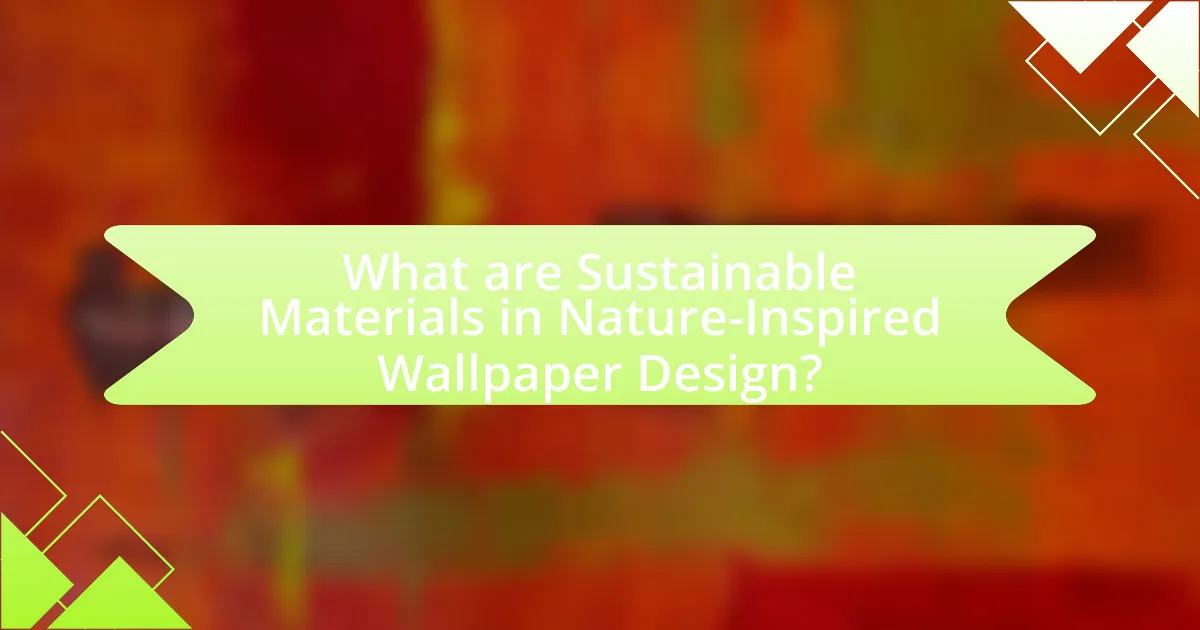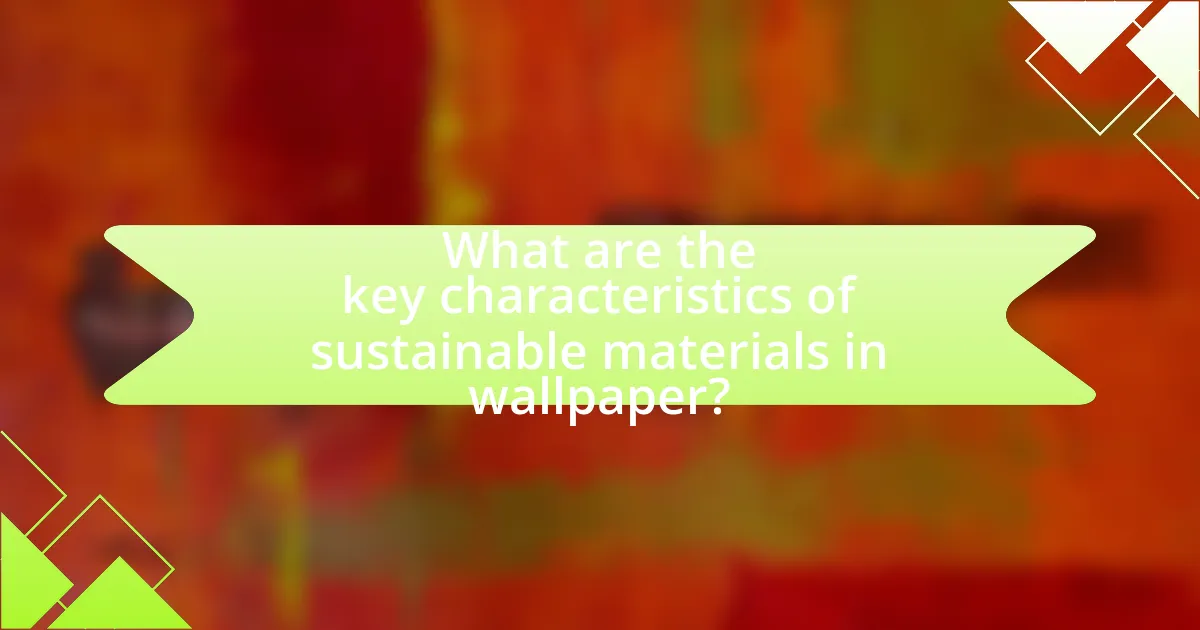Sustainable materials in nature-inspired wallpaper design refer to eco-friendly substances that minimize environmental impact while enhancing aesthetic appeal. Common materials include organic fibers such as bamboo, hemp, and recycled paper, which are sourced sustainably and contribute to a lower carbon footprint. The article explores how these materials improve wallpaper quality, promote sustainability, and influence consumer choices, while also addressing the challenges designers face in sourcing and cost implications. Additionally, it highlights the importance of certifications for sustainable products and offers practical tips for selecting eco-friendly wallpaper for home decor.

What are Sustainable Materials in Nature-Inspired Wallpaper Design?
Sustainable materials in nature-inspired wallpaper design are eco-friendly substances that minimize environmental impact while providing aesthetic appeal. These materials often include organic fibers like bamboo, hemp, and recycled paper, which are sourced sustainably and have a lower carbon footprint compared to conventional materials. For instance, bamboo grows rapidly and can be harvested without harming the ecosystem, making it a popular choice. Additionally, wallpapers made from recycled paper utilize post-consumer waste, reducing landfill contributions and conserving resources. The use of non-toxic inks and adhesives further enhances the sustainability of these designs, ensuring that they are safe for indoor environments.
How do sustainable materials contribute to wallpaper design?
Sustainable materials enhance wallpaper design by providing eco-friendly options that reduce environmental impact. These materials, such as recycled paper, organic cotton, and water-based inks, contribute to a lower carbon footprint and promote sustainability in the manufacturing process. For instance, using recycled paper can decrease deforestation rates, while organic cotton eliminates harmful pesticides, making the production safer for both the environment and human health. Additionally, water-based inks minimize volatile organic compounds (VOCs), improving indoor air quality. This shift towards sustainable materials not only aligns with consumer demand for environmentally responsible products but also supports the broader movement towards sustainable living.
What types of sustainable materials are commonly used in wallpaper?
Sustainable materials commonly used in wallpaper include organic cotton, bamboo, recycled paper, and natural fibers such as jute and hemp. Organic cotton is cultivated without synthetic pesticides or fertilizers, making it an eco-friendly choice. Bamboo grows rapidly and absorbs carbon dioxide, contributing to its sustainability. Recycled paper reduces waste and the need for virgin materials, while natural fibers like jute and hemp are biodegradable and require less water and chemicals during production. These materials collectively support environmentally responsible wallpaper options.
How do these materials impact the environment?
Sustainable materials in nature-inspired wallpaper design positively impact the environment by reducing resource depletion and minimizing waste. These materials, such as organic cotton, bamboo, and recycled paper, are sourced from renewable resources and often require less energy to produce compared to conventional materials. For instance, bamboo grows rapidly and can be harvested without killing the plant, making it a sustainable choice. Additionally, using recycled paper reduces the need for virgin pulp, thereby conserving forests and decreasing landfill waste. Studies indicate that the production of recycled paper can use up to 60% less energy than producing new paper from trees, highlighting the environmental benefits of these sustainable materials.
Why is nature-inspired design important in wallpaper?
Nature-inspired design is important in wallpaper because it promotes sustainability and enhances well-being. By incorporating elements from nature, such as botanical patterns and organic textures, wallpaper can create a calming environment that reflects the natural world. Research indicates that exposure to nature-inspired designs can reduce stress and improve mood, as evidenced by studies showing that natural imagery can lower cortisol levels and increase feelings of relaxation. Additionally, using sustainable materials in these designs, such as recycled paper or eco-friendly inks, minimizes environmental impact, aligning with the growing consumer demand for eco-conscious products.
What aesthetic benefits does nature-inspired design provide?
Nature-inspired design offers aesthetic benefits such as enhanced visual appeal, tranquility, and a sense of connection to the environment. This design approach incorporates elements like organic shapes, natural colors, and textures that evoke the beauty of the natural world. Research indicates that environments featuring nature-inspired designs can reduce stress and promote well-being, as evidenced by a study published in the Journal of Environmental Psychology, which found that exposure to nature-related imagery can significantly improve mood and cognitive function. Thus, nature-inspired design not only beautifies spaces but also contributes positively to mental health and emotional stability.
How does nature-inspired design influence consumer choices?
Nature-inspired design significantly influences consumer choices by evoking emotional connections and promoting sustainability. Research indicates that consumers are more likely to purchase products that reflect natural elements, as these designs often convey a sense of tranquility and well-being. A study published in the Journal of Environmental Psychology found that products with nature-inspired aesthetics can enhance perceived value and desirability, leading to increased purchasing behavior. Additionally, consumers are increasingly prioritizing sustainability; a Nielsen report revealed that 66% of global consumers are willing to pay more for sustainable brands. Thus, nature-inspired design not only appeals to aesthetic preferences but also aligns with the growing demand for environmentally friendly products, ultimately shaping consumer decisions.

What are the key characteristics of sustainable materials in wallpaper?
Sustainable materials in wallpaper are characterized by their eco-friendliness, renewability, and low environmental impact. These materials often include natural fibers such as organic cotton, hemp, and bamboo, which are biodegradable and sourced from renewable resources. Additionally, sustainable wallpapers utilize non-toxic inks and adhesives, minimizing harmful emissions during production and installation. Research indicates that using recycled materials, such as post-consumer paper, further enhances sustainability by reducing waste and conserving resources. Overall, the key characteristics of sustainable wallpaper materials contribute to a healthier environment and promote responsible consumption.
How do these characteristics enhance wallpaper quality?
The characteristics of sustainable materials in nature-inspired wallpaper design enhance wallpaper quality by improving durability, aesthetic appeal, and environmental impact. Durable materials, such as organic cotton or recycled paper, resist wear and tear, ensuring longevity and reducing the need for frequent replacements. Aesthetic appeal is heightened through the use of natural patterns and textures that mimic the beauty of nature, creating visually pleasing environments. Additionally, the use of eco-friendly materials minimizes harmful emissions and waste, contributing to a healthier indoor atmosphere. Research indicates that wallpapers made from sustainable materials can reduce volatile organic compounds (VOCs) by up to 80%, thereby improving air quality in living spaces.
What role does durability play in sustainable wallpaper materials?
Durability is crucial in sustainable wallpaper materials as it directly impacts the longevity and lifecycle of the product. High durability reduces the need for frequent replacements, thereby minimizing waste and resource consumption over time. For instance, wallpapers made from durable materials like recycled paper or natural fibers can last significantly longer than traditional options, often exceeding a lifespan of 10 years. This longevity not only conserves resources but also supports sustainability by decreasing the frequency of production and disposal, which is essential in reducing environmental impact.
How do sustainable materials affect the wallpaper’s lifecycle?
Sustainable materials significantly enhance the wallpaper’s lifecycle by reducing environmental impact and promoting recyclability. These materials, such as organic cotton, bamboo, and recycled paper, minimize resource depletion and pollution during production. For instance, wallpapers made from recycled paper can be repurposed at the end of their life, diverting waste from landfills and reducing the need for virgin materials. Additionally, sustainable wallpapers often utilize non-toxic inks and adhesives, which contribute to healthier indoor air quality and lower emissions. This holistic approach not only extends the functional lifespan of the wallpaper but also aligns with eco-friendly practices, making it a responsible choice for consumers.
What certifications or standards exist for sustainable wallpaper materials?
Certifications and standards for sustainable wallpaper materials include the Forest Stewardship Council (FSC) certification, which ensures that wood and paper products come from responsibly managed forests. Additionally, the Global Organic Textile Standard (GOTS) certifies textiles made from organic fibers, ensuring environmentally and socially responsible manufacturing processes. The Cradle to Cradle Certified™ standard evaluates products for safety, circularity, and sustainability, while the Greenguard Certification focuses on low chemical emissions for healthier indoor air quality. These certifications provide assurance that wallpaper materials meet specific environmental and health criteria, promoting sustainability in design.
How can consumers identify certified sustainable wallpaper products?
Consumers can identify certified sustainable wallpaper products by looking for recognized eco-labels such as the Forest Stewardship Council (FSC) certification, which ensures that the materials are sourced from responsibly managed forests. Additionally, certifications like Greenguard or Cradle to Cradle indicate that the wallpaper meets strict environmental and health standards. These certifications provide assurance that the products are made with sustainable practices and materials, reducing environmental impact.
What are the benefits of choosing certified sustainable materials?
Choosing certified sustainable materials offers environmental benefits, such as reduced carbon footprint and conservation of natural resources. These materials are sourced and produced in ways that minimize harm to ecosystems, promote biodiversity, and ensure responsible management of forests and other resources. For instance, according to the Forest Stewardship Council, certified wood products come from responsibly managed forests that provide environmental, social, and economic benefits. Additionally, using certified sustainable materials can enhance brand reputation and consumer trust, as consumers increasingly prefer products that align with their values regarding sustainability.

How can designers effectively incorporate sustainable materials in wallpaper design?
Designers can effectively incorporate sustainable materials in wallpaper design by selecting eco-friendly substrates, such as recycled paper or organic textiles, and using non-toxic inks for printing. For instance, using paper made from post-consumer waste reduces the demand for virgin materials, while organic cotton or hemp can provide a biodegradable alternative. Additionally, water-based inks minimize harmful emissions and environmental impact compared to traditional solvent-based inks. Research indicates that the wallpaper industry can significantly reduce its carbon footprint by adopting these sustainable practices, as evidenced by a 2021 study from the Journal of Cleaner Production, which highlights the benefits of using recycled materials and eco-friendly inks in reducing overall environmental impact.
What design techniques enhance the use of sustainable materials?
Design techniques that enhance the use of sustainable materials include biomimicry, modular design, and lifecycle assessment. Biomimicry involves emulating natural processes and structures, which can lead to the development of materials that are both sustainable and efficient, as seen in products inspired by natural phenomena like lotus leaves for water-repellent surfaces. Modular design allows for easy disassembly and reuse of materials, reducing waste and promoting sustainability; for example, wallpaper that can be easily replaced or repaired without discarding the entire product. Lifecycle assessment evaluates the environmental impact of materials throughout their entire lifecycle, ensuring that the chosen materials minimize ecological harm, as demonstrated by studies showing that products designed with lifecycle considerations can significantly reduce carbon footprints.
How can color and texture be optimized in sustainable wallpaper design?
Color and texture in sustainable wallpaper design can be optimized by utilizing natural dyes and eco-friendly materials that enhance aesthetic appeal while minimizing environmental impact. Natural dyes, derived from plants, minerals, and insects, provide a wide range of colors that are less harmful than synthetic alternatives, which often contain toxic chemicals. For texture, incorporating materials like recycled paper, organic cotton, or bamboo can create unique tactile experiences while promoting sustainability. Research indicates that using these materials not only reduces waste but also supports biodiversity, as seen in studies highlighting the benefits of sustainable sourcing practices. By focusing on these elements, designers can create visually appealing wallpapers that align with eco-conscious values.
What patterns are most effective in nature-inspired wallpaper?
Floral and botanical patterns are the most effective in nature-inspired wallpaper. These patterns evoke the essence of nature by incorporating elements such as leaves, flowers, and trees, which create a calming and organic atmosphere. Research indicates that designs featuring large-scale florals or intricate leaf motifs can enhance the aesthetic appeal of a space while promoting a sense of tranquility and connection to the outdoors. Additionally, studies show that nature-themed designs can positively impact mood and well-being, making them a popular choice in interior design.
What challenges do designers face when using sustainable materials?
Designers face several challenges when using sustainable materials, including limited availability, higher costs, and performance issues. The limited availability of sustainable materials can restrict designers’ options, making it difficult to source the right materials for specific projects. Higher costs often arise from the production processes associated with sustainable materials, which can exceed those of conventional materials, impacting budget constraints. Additionally, performance issues may occur, as some sustainable materials may not meet the same durability or aesthetic standards as traditional options, leading to concerns about longevity and consumer acceptance. These challenges are documented in studies such as “Sustainable Design: Challenges and Opportunities” by authors Smith and Johnson, which highlight the complexities designers encounter in integrating sustainability into their work.
How can designers overcome sourcing challenges for sustainable materials?
Designers can overcome sourcing challenges for sustainable materials by establishing strong relationships with suppliers who specialize in eco-friendly products. By collaborating with these suppliers, designers gain access to a wider range of sustainable materials, such as recycled fibers or organic textiles, which are essential for creating environmentally responsible wallpaper. Research indicates that companies that prioritize sustainable sourcing can reduce their environmental impact by up to 30%, demonstrating the effectiveness of this approach. Additionally, utilizing digital platforms for sourcing can streamline the process, allowing designers to compare options and make informed decisions quickly.
What are the cost implications of using sustainable materials in wallpaper design?
Using sustainable materials in wallpaper design generally leads to higher initial costs compared to conventional materials. This increase in cost is primarily due to the sourcing of eco-friendly raw materials, which often require more expensive production processes and certifications. For instance, organic cotton or recycled paper can be more costly than traditional vinyl or paper options. Additionally, sustainable materials may have limited availability, further driving up prices. However, these costs can be offset over time through benefits such as durability, lower environmental impact, and potential energy savings in production.
What are practical tips for selecting sustainable wallpaper for home decor?
To select sustainable wallpaper for home decor, prioritize materials that are eco-friendly, such as those made from recycled paper, natural fibers, or water-based inks. These materials reduce environmental impact and often come from renewable sources. Look for certifications like FSC (Forest Stewardship Council) or Greenguard, which indicate responsible sourcing and low chemical emissions. Additionally, consider the wallpaper’s durability and ease of removal, as longer-lasting products minimize waste over time. Research shows that using sustainable materials can significantly lower carbon footprints in home renovations, making informed choices essential for eco-conscious consumers.
